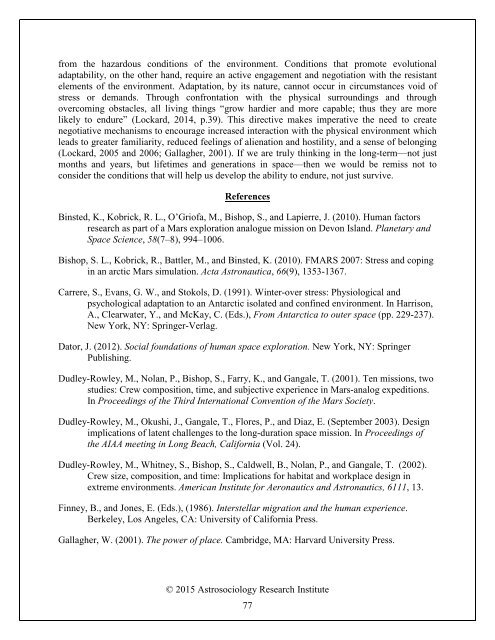THE JOURNAL OF ASTROSOCIOLOGY VOLUME 1
qd9nb3s
qd9nb3s
- No tags were found...
You also want an ePaper? Increase the reach of your titles
YUMPU automatically turns print PDFs into web optimized ePapers that Google loves.
from the hazardous conditions of the environment. Conditions that promote evolutionaladaptability, on the other hand, require an active engagement and negotiation with the resistantelements of the environment. Adaptation, by its nature, cannot occur in circumstances void ofstress or demands. Through confrontation with the physical surroundings and throughovercoming obstacles, all living things “grow hardier and more capable; thus they are morelikely to endure” (Lockard, 2014, p.39). This directive makes imperative the need to createnegotiative mechanisms to encourage increased interaction with the physical environment whichleads to greater familiarity, reduced feelings of alienation and hostility, and a sense of belonging(Lockard, 2005 and 2006; Gallagher, 2001). If we are truly thinking in the long-term—not justmonths and years, but lifetimes and generations in space—then we would be remiss not toconsider the conditions that will help us develop the ability to endure, not just survive.ReferencesBinsted, K., Kobrick, R. L., O’Griofa, M., Bishop, S., and Lapierre, J. (2010). Human factorsresearch as part of a Mars exploration analogue mission on Devon Island. Planetary andSpace Science, 58(7–8), 994–1006.Bishop, S. L., Kobrick, R., Battler, M., and Binsted, K. (2010). FMARS 2007: Stress and copingin an arctic Mars simulation. Acta Astronautica, 66(9), 1353-1367.Carrere, S., Evans, G. W., and Stokols, D. (1991). Winter-over stress: Physiological andpsychological adaptation to an Antarctic isolated and confined environment. In Harrison,A., Clearwater, Y., and McKay, C. (Eds.), From Antarctica to outer space (pp. 229-237).New York, NY: Springer-Verlag.Dator, J. (2012). Social foundations of human space exploration. New York, NY: SpringerPublishing.Dudley-Rowley, M., Nolan, P., Bishop, S., Farry, K., and Gangale, T. (2001). Ten missions, twostudies: Crew composition, time, and subjective experience in Mars-analog expeditions.In Proceedings of the Third International Convention of the Mars Society.Dudley-Rowley, M., Okushi, J., Gangale, T., Flores, P., and Diaz, E. (September 2003). Designimplications of latent challenges to the long-duration space mission. In Proceedings ofthe AIAA meeting in Long Beach, California (Vol. 24).Dudley-Rowley, M., Whitney, S., Bishop, S., Caldwell, B., Nolan, P., and Gangale, T. (2002).Crew size, composition, and time: Implications for habitat and workplace design inextreme environments. American Institute for Aeronautics and Astronautics, 6111, 13.Finney, B., and Jones, E. (Eds.), (1986). Interstellar migration and the human experience.Berkeley, Los Angeles, CA: University of California Press.Gallagher, W. (2001). The power of place. Cambridge, MA: Harvard University Press.© 2015 Astrosociology Research Institute77


